Impact of Extreme Drought on Vegetation Greenness in Poyang Lake Wetland
Abstract
:1. Introduction
2. Data and Methodology
2.1. Research Area
2.2. Data Sources
2.3. Methods
2.3.1. SPEI
2.3.2. Trend Analysis
2.3.3. Threshold Identification
3. Results
3.1. The SPEI Trend Analysis in the Poyang Lake Basin
3.2. The Analysis of the Spatiotemporal Characteristics of Vegetation in Poyang Lake Wetlands
3.3. The Correlation Analysis and Threshold Identification
4. Discussion
4.1. Spatial and Temporal Scales of Vegetation Response to Drought
4.2. Lagged Impact of Extreme Drought on Vegetation Greenness
4.3. Impact of Water Level Fluctuation Thresholds on Vegetation
5. Conclusions and Outlook
- (1)
- The drought conditions in Poyang Lake have worsened over the past 3 years, reaching an extreme state in August 2022. The SPEI and the water level trends were inconsistent; however, during rapid transitions between drought and flood, changes in the SPEI and the water levels were aligned.
- (2)
- Regarding the wetland vegetation in Poyang Lake, the area of wetland vegetation and its greenness showed opposite trends. Under extreme drought conditions, the wetland vegetation area expanded rapidly, with a significant decrease in greenness, although it did not reach the minimum value. In spring, following an extreme drought year, the greenness value of the Poyang Lake Wetland vegetation was lower than that in 2021 and 2022. Regarding NDVI classification, the largest area of wetland vegetation fell within the range of 0–0.2, followed by 0.2–0.4.
- (3)
- The correlation analysis showed no significant correlation between the SPEI and the vegetation, indicating that the water level is a key factor significantly affecting the vegetation of the Poyang Lake wetlands (p < 0.001). When water level thresholds reach 10 and 14 m, the area of wetland vegetation with an NDVI ranging from 0.2 to 0.4 and the average NDVI values suddenly decrease. When the water level threshold reaches 12 m, the area of wetland vegetation with an NDVI ranging from 0 to 0.2 stops decreasing and tends to stabilise.
- (1)
- The lack of differentiation among wetland plant species. This study did not consider whether there are differences in greenness among these species. Future research should distinguish the greenness characteristics of wetland plant species and investigate their responses to drought stress.
- (2)
- Insufficient research on drought transmission mechanisms. Due to data availability, this study only considered the impacts of meteorological and hydrological droughts on vegetation. In the future, smaller time intervals should be used to explore how meteorological drought, hydrological drought, and agricultural drought transmit the thresholds that trigger this transmission and the characteristics exhibited by vegetation during this process.
- (3)
- The lack of consideration for inundation duration and depth. This study only focused on whether wetland vegetation was inundated. Future research should enhance the investigation of changes in wetland vegetation greenness under different inundation durations and depths.
Author Contributions
Funding
Data Availability Statement
Acknowledgments
Conflicts of Interest
References
- Aragão, L.E.; Anderson, L.O.; Fonseca, M.G.; Rosan, T.M.; Vedovato, L.B.; Wagner, F.H.; Silva, C.V.; Silva Junior, C.H.; Arai, E.; Aguiar, A.P.; et al. 21st Century drought-related fires counteract the decline of Amazon deforestation carbon emissions. Nat. Commun. 2018, 9, 536. [Google Scholar] [CrossRef] [PubMed]
- Brando, P.M.; Balch, J.K.; Nepstad, D.C.; Morton, D.C.; Putz, F.E.; Coe, M.T.; Silvério, D.; Macedo, M.N.; Davidson, E.A.; Nóbrega, C.C.; et al. Abrupt increases in Amazonian tree mortality due to drought–fire interactions. Proc. Natl. Acad. Sci. USA 2014, 111, 6347–6352. [Google Scholar] [CrossRef] [PubMed]
- Ponce-Campos, G.E.; Moran, M.S.; Huete, A.; Zhang, Y.; Bresloff, C.; Huxman, T.E.; Eamus, D.; Bosch, D.D.; Buda, A.R.; Gunter, S.A.; et al. Ecosystem resilience despite large-scale altered hydroclimatic conditions. Nature 2013, 494, 349–352. [Google Scholar] [CrossRef]
- Li, J.; Pei, J.; Fang, C.; Li, B.; Nie, M. Drought may exacerbate dryland soil inorganic carbon loss under warming climate conditions. Nat. Commun. 2024, 15, 617. [Google Scholar] [CrossRef] [PubMed]
- Cao, D.; Zhang, J.; Han, J.; Zhang, T.; Yang, S.; Wang, J.; Prodhan, F.A.; Yao, F. Projected increases in global terrestrial net primary productivity loss caused by drought under climate change. Earth’s Futur. 2022, 10, e2022EF002681. [Google Scholar] [CrossRef]
- Cunha, A.P.; Zeri, M.; Deusdará Leal, K.; Costa, L.; Cuartas, L.A.; Marengo, J.A.; Tomasella, J.; Vieira, R.M.; Barbosa, A.A.; Cunningham, C.; et al. Extreme drought events over Brazil from 2011 to 2019. Atmosphere 2019, 10, 642. [Google Scholar] [CrossRef]
- Schuldt, B.; Buras, A.; Arend, M.; Vitasse, Y.; Beierkuhnlein, C.; Damm, A.; Gharun, M.; Grams, T.E.E.; Hauck, M.; Hajek, P.; et al. A first assessment of the impact of the extreme 2018 summer drought on Central European forests. Basic Appl. Ecol. 2020, 45, 86–103. [Google Scholar] [CrossRef]
- Wang, W.; Shi, K.; Wang, X.; Wang, S.; Zhang, D.; Peng, Y.; Li, N.; Zhang, Y.; Zhang, Y.; Qin, B.; et al. A record-breaking extreme heat event caused unprecedented warming of lakes in China. Sci. Bull. 2023, 68, 578–582. [Google Scholar] [CrossRef]
- Hu, Z. Serious drought in Poyang Lake in 2022 and countermeasures fordrought prevention and disaster reduction. China FloodDrought Manag. 2023, 33, 1–6. [Google Scholar]
- Li, X.; Zhang, Q.; Zhang, D.; Ye, X. Investigation of the drought–flood abrupt alternation of streamflow in Poyang Lake catchment during the last 50 years. Hydrol. Res. 2016, 48, 1402–1417. [Google Scholar] [CrossRef]
- Li, X.; Ye, X. Spatiotemporal Characteristics of dry-wet abrupt transition based on precipitation in Poyang Lake Basin, China. Water 2015, 7, 1943–1958. [Google Scholar] [CrossRef]
- Wang, R.; Peng, W.; Liu, X.; Wu, W.; Chen, X.; Zhang, S. Responses of water level in China’s largest freshwater lake to the meteorological drought index (SPEI) in the past five decades. Water 2018, 10, 137. [Google Scholar] [CrossRef]
- Zhang, D.; Chen, P.; Zhang, Q.; Li, X. Copula-based probability of concurrent hydrological drought in the Poyang lake-catchment-river system (China) from 1960 to 2013. J. Hydrol. 2017, 553, 773–784. [Google Scholar] [CrossRef]
- Liu, Y.; Wu, G. Hydroclimatological influences on recently increased droughts in China’s largest freshwater lake. Hydrol. Earth Syst. Sci. 2016, 20, 93–107. [Google Scholar] [CrossRef]
- Liu, J.; Lu, J.; Tian, Q.; Chen, X. Impact of drought on GEP of Poyang Lake basin vegetation ecosystem. J. Cent. China Norm. Univ. (Nat. Sci.) 2022, 56, 513–522. [Google Scholar] [CrossRef]
- Mei, X.; Dai, Z.; Du, J.; Chen, J. Linkage between Three Gorges Dam impacts and the dramatic recessions in China’s largest freshwater lake, Poyang Lake. Sci. Rep. 2015, 5, 18197. [Google Scholar] [CrossRef]
- Xu, L.; Lai, X.; Wan, R.; Wang, X.; Li, X. Review of the development of lake wetlands eco-hydrology and case studies. Prog. Geogr. 2019, 38, 1171–1181. [Google Scholar] [CrossRef]
- Luo, J.; Yan, Y.; Xiao, F.; Cao, S.; Chen, M.; Du, Y. Monitoring and analysis of the Poyang Lake wetlands drought process in 2022 based on spatio-temporal information fusion Model. J. Lake Sci. 2024, 36, 1525–1536. [Google Scholar] [CrossRef]
- Ye, X.; Li, X.; Liu, J.; Xu, C.Y.; Zhang, Q. Response of wetland vegetation to drought and its impact factors in the Poyang Lake National Nature Reserve. J. Lake Sci. 2014, 26, 253–259. [Google Scholar]
- Li, X.; Wang, K.; Huntingford, C.; Zhu, Z.; Peñuelas, J.; Myneni, R.B.; Piao, S. Vegetation greenness in 2023. Nat. Reviews. Earth Environ. 2024, 5, 241–243. [Google Scholar] [CrossRef]
- Li, W.; Pacheco-Labrador, J.; Migliavacca, M.; Miralles, D.; van Dijke, A.H.; Reichstein, M.; Forkel, M.; Zhang, W.; Frankenberg, C.; Panwar, A.; et al. Widespread and complex drought effects on vegetation physiology inferred from space. Nat. Commun. 2023, 14, 1–13. [Google Scholar] [CrossRef] [PubMed]
- Sungmin, O.; Park, S.K. Global ecosystem responses to flash droughts are modulated by background climate and vegetation conditions. Commun. Earth Environ. 2024, 5, 88. [Google Scholar]
- Ault, T.R. On the essentials of drought in a changing climate. Science 2020, 368, 256–260. [Google Scholar] [CrossRef] [PubMed]
- Allen, C.D.; Breshears, D.D.; McDowell, N.G. On underestimation of global vulnerability to tree mortality and forest die-off from hotter drought in the Anthropocene. Ecosphere 2015, 6, 1–55. [Google Scholar] [CrossRef]
- Spinoni, J.; Barbosa, P.; De Jager, A.; McCormick, N.; Naumann, G.; Vogt, J.V.; Magni, D.; Masante, D.; Mazzeschi, M. A new global database of meteorological drought events from 1951 to 2016. J. Hydrol. Reg. Stud. 2019, 22, 100593. [Google Scholar] [CrossRef] [PubMed]
- Wang, Q.; Zeng, J.; Qi, J.; Zhang, X.; Zeng, Y.; Shui, W.; Xu, Z.; Zhang, R.; Wu, X.; Cong, J. A multi-scale daily SPEI dataset for drought characterization at observation stations over mainland China from 1961 to 2018. Earth Syst. Sci. Data 2021, 13, 331–341. [Google Scholar] [CrossRef]
- Greenwood, S.; Ruiz-Benito, P.; Martínez-Vilalta, J.; Lloret, F.; Kitzberger, T.; Allen, C.D.; Fensham, R.; Laughlin, D.C.; Kattge, J.; Bönisch, G.; et al. Tree mortality across biomes is promoted by drought intensity, lower wood density and higher specific leaf area. Ecol. Lett. 2017, 20, 539–553. [Google Scholar] [CrossRef]
- Li, X.; Piao, S.; Huntingford, C.; Peñuelas, J.; Yang, H.; Xu, H.; Chen, A.; Friedlingstein, P.; Keenan, T.F.; Sitch, S.; et al. Global variations in critical drought thresholds that impact vegetation. Natl. Sci. Rev. 2023, 10, nwad049. [Google Scholar] [CrossRef]
- Berdugo, M.; Delgado-Baquerizo, M.; Soliveres, S.; Hernández-Clemente, R.; Zhao, Y.; Gaitán, J.J.; Gross, N.; Saiz, H.; Maire, V.; Lehmann, A.; et al. Global ecosystem thresholds driven by aridity. Science 2020, 367, 787–790. [Google Scholar] [CrossRef]
- Tang, J.; Niu, B.; Hu, Z.; Zhang, X. Increasing susceptibility and shortening response time of vegetation productivity to drought from 2001 to 2021. Agric. For. Meteorol. 2024, 352, 110025. [Google Scholar] [CrossRef]
- Hong, X.; Guo, S.; Xiong, L.; Liu, Z. Spatial and temporal analysis of drought using entropy-based standardized precipitation index: A case study in Poyang Lake basin, China. Theor. Appl. Clim. 2014, 122, 543–556. [Google Scholar] [CrossRef]
- Yao, Y.; Liu, Y.; Fu, F.; Song, J.; Wang, Y.; Han, Y.; Wu, T.; Fu, B. Declined terrestrial ecosystem resilience. Glob. Chang. Biol. 2024, 30, e17291. [Google Scholar] [CrossRef]
- Piao, Z.; Li, X.; Xu, H.; Wang, K.; Tang, S.; Kan, F.; Hong, S. Threshold of climate extremes that impact vegetation productivity over the Tibetan Plateau. Sci. China Earth Sci. 2024, 67, 1967–1977. [Google Scholar] [CrossRef]
- Zhang, Q.; Xue, C.; Xia, J. Impact, contributing factors and countermeasures of extreme droughts in Poyang Lake. Bull. Chin. Acad. Sci. 2023, 38, 1894–1902. [Google Scholar]
- Tan, Z.; Zhang, Q.; Li, Y.; Xu, X.; Jiang, J. Distribution of typical vegetation communities along elevation in Poyang Lake wetlands. Wetl. Sci. 2016, 14, 506–515. [Google Scholar]
- Li, B.; Wan, R.; Yang, G.; Tan, Z.; Wang, D.; Wu, X. Investigating spatiotemporal dynamics of Lake Poyang wetland for the recent century. J. Lake Sci. 2022, 34, 1018–1029. [Google Scholar]
- Shuhua, Q.I.; Xiaobo, S.H.; Daniel, B. Flooding hazard mapping for Poyang Lake Region with remote sensing and water level rec-ords. J. Lake Sci. 2009, 21, 720–724. [Google Scholar] [CrossRef]
- Xie, D.; Zhou, Y.; Qian, H. Poyang Lake Wetland Complex Ecosystem Research; Science Press: Beijing, China, 2018. [Google Scholar]
- Xie, K.; Ding, M.; Zhang, H.; Chen, L. Spatiotemporal variation of drought in Poyang Lake Basin in recent sixty years Based on SPEI. Resour. Environ. Yangtze Basin 2021, 30, 2015–2027. [Google Scholar]
- Vicente-Serrano, S.M.; Beguería, S.; López-Moreno, J.I. A multiscalar drought index sensitive to global warming: The standardized precipitation evapotranspiration index. J. Clim. 2010, 23, 1696–1718. [Google Scholar] [CrossRef]
- Beguería, S.; Vicente-Serrano, S.M.; Reig, F.; Latorre, B. Standardized precipitation evapotranspiration index (SPEI) revisited: Parameter fitting, evapotranspiration models, tools, datasets and drought monitoring. Int. J. Clim. 2013, 34, 3001–3023. [Google Scholar] [CrossRef]
- Perez, M.; Lombardi, D.; Bardino, G.; Vitale, M. Drought assessment through actual evapotranspiration in Mediterranean vegetation dynamics. Ecol. Indic. 2024, 166. [Google Scholar] [CrossRef]
- Rahman, N.; Rony, R.H.; Jannat, F.A. Spatiotemporal evaluation of drought trend during 1979–2019 in seven climatic zones of Bangladesh. Heliyon 2021, 7, e08249. [Google Scholar] [CrossRef] [PubMed]
- En-Nagre, K.; Aqnouy, M.; Ouarka, A.; Naqvi, S.A.; Bouizrou, I.; El Messari, J.E.; Tariq, A.; Soufan, W.; Li, W.; El-Askary, H. Assessment and prediction of meteorological drought using machine learning algorithms and climate data. Clim. Risk Manag. 2024, 45, 100630. [Google Scholar] [CrossRef]
- Bera, B.; Shit, P.K.; Sengupta, N.; Saha, S.; Bhattacharjee, S. Trends and variability of drought in the extended part of Chhota Nagpur plateau (Singbhum Protocontinent), India applying SPI and SPEI indices. Environ. Chall. 2021, 5, 100310. [Google Scholar] [CrossRef]
- Wood, S.N. Generalized Additive Models: An Introduction with R; Chapman and Hall/CRC: Boca Raton, FL, USA, 2017. [Google Scholar]
- Kang, P.; Zhang, X.; Hu, C. Study of the spatial and temporal distribution of ozone and its influences factors over Sichuan Basin based on generalized additive mode. Acta Sci. Circumstantiae 2019, 39, 809–820. [Google Scholar]
- Hao, C.; Sun, X.; Wang, H. Application of Generalized Linear Geostatistical Model for digital soil mapping in typical subtropical hilly area. Acta Pedol. Sin. 2023, 60, 993–1006. [Google Scholar]
- Peng, J.; Tian, L.; Liu, Y.; Zhao, M.; Hu, Y.; Wu, J. Ecosystem services response to urbanization in metropolitan areas: Thresholds identification. Sci. Total Environ. 2017, 607–608, 706–714. [Google Scholar] [CrossRef]
- Toms, J.D.; Lesperance, M.L. Piecewise regression: A tool for identifying ecological thresholds. Ecology 2003, 84, 2034–2041. [Google Scholar] [CrossRef]
- Xue, C.; Zhang, Q.; Jia, Y.; Yuan, S. Intensifying drought of Poyang Lake and potential recovery approaches in the dammed middle Yangtze River catchment. J. Hydrol. Reg. Stud. 2023, 50, 101548. [Google Scholar] [CrossRef]
- Chen, L.; Zhu, X.; Tang, Y.; Liu, T.; Zhang, S.; Lu, Y.; Xu, K.; Guo, R. Time lag effect and influencing factors of meteorological and hydrological drought in the Yellow River Basin. Sci. Geogr. Sin. 2023, 43, 1861–1868. [Google Scholar]
- Zheng, J.; Zhou, Z.; Liu, J.; Yan, Z.; Li, G.; Wang, Q. Influencing mechanism of meteorological drought to hydrological drought propagation in the Fuhe River Basin. J. Water Resour. Hydropower Eng. 2023, 34, 27–34. [Google Scholar]
- Vicente-Serrano, S.M.; Gouveia, C.; Camarero, J.J.; Beguería, S.; Trigo, R.; Lopez-Moreno, J.I.; Azorin-Molina, C.; Pasho, E.; Lorenzo-Lacruz, J.; Revuelto, J.; et al. Response of vegetation to drought time-scales across global land biomes. Proc. Natl. Acad. Sci. USA 2013, 110, 52–57. [Google Scholar] [CrossRef] [PubMed]
- Zhang, Q.; Yu, X.; Hu, B. Research on the characteristics of plant communities in the Poyang Nanji Wetlands, China. Resour. Sci. 2013, 35, 42–49. [Google Scholar]
- Li, D.; An, L.; Zhong, S.; Shen, L.; Wu, S. Declining coupling between vegetation and drought over the past three decades. Glob. Chang. Biol. 2024, 30, e17141. [Google Scholar] [CrossRef]
- Cui, J.; Chen, A.; Huntingford, C.; Piao, S. Integrating ecosystem water demands into drought monitoring and assessment under climate change. Nat. Water 2024, 2, 215–218. [Google Scholar] [CrossRef]
- Wei, X.; He, W.; Zhou, Y.; Ju, W.; Xiao, J.; Li, X.; Liu, Y.; Xu, S.; Bi, W.; Zhang, X.; et al. Global assessment of lagged and cumulative effects of drought on grassland gross primary pro-duction. Ecol. Indic. 2022, 136, 108646. [Google Scholar] [CrossRef]
- Van Loon, A.; Laaha, G. Hydrological drought severity explained by climate and catchment characteristics. J. Hydrol. 2015, 526, 3–14. [Google Scholar] [CrossRef]
- Zhang, Q.; Ye, X.; Werner, A.D.; Li, Y.; Yao, J.; Li, X.; Xu, C. An investigation of enhanced recessions in Poyang Lake: Comparison of Yangtze River and local catchment impacts. J. Hydrol. 2014, 517, 425–434. [Google Scholar] [CrossRef]
- Zhang, Z.; Huang, Y.; Xu, C.; Chen, X.; Moss, E.M.; Jin, Q.; Bailey, A.M. Analysis of Poyang Lake water balance and its indication of river–lake interaction. SpringerPlus 2016, 5, 1555. [Google Scholar] [CrossRef] [PubMed]
- Zhang, Z.; Chen, X.; Xu, C.; Hong, Y.; Hardy, J.; Sun, Z. Examining the influence of river–lake interaction on the drought and water resources in the Poyang Lake basin. J. Hydrol. 2015, 522, 510–521. [Google Scholar] [CrossRef]
- Gao, J.; Jia, J.; Kettner, A.J.; Xing, F.; Wang, Y.; Xu, X.; Yang, Y.; Zou, X.; Gao, S.; Qi, S.; et al. Changes in water and sediment exchange between the Changjiang River and Poyang Lake under natural and anthropogenic conditions, China. Sci. Total Environ. 2014, 481, 542–553. [Google Scholar] [CrossRef]
- Tan, Z.; Jiang, J. Spatial–temporal dynamics of wetland vegetation related to water level fluctuations in Poyang Lake, China. Water 2016, 8, 397. [Google Scholar] [CrossRef]
- Li, Z.; Sun, F.; Wang, H.; Wang, T.; Feng, Y. Detecting the interactions between vegetation greenness and drought globally. Atmospheric Res. 2024, 304, 107409. [Google Scholar] [CrossRef]
- Feng, W.; Lu, H.; Yao, T.; Yu, Q. Drought characteristics and its elevation dependence in the Qinghai–Tibet plateau during the last half-century. Sci. Rep. 2020, 10, 14323. [Google Scholar] [CrossRef]
- Zhang, Q.; Kong, D.; Singh, V.P.; Shi, P. Response of vegetation to different time-scales drought across China: Spatiotemporal patterns, causes and implications. Glob. Planet. Chang. 2017, 152, 1–11. [Google Scholar] [CrossRef]
- Christian, J.I.; Basara, J.B.; Hunt, E.D.; Otkin, J.A.; Furtado, J.C.; Mishra, V.; Xiao, X.; Randall, R.M. Global distribution, trends, and drivers of flash drought occurrence. Nat. Commun. 2021, 12, 6330. [Google Scholar] [CrossRef]
- Salimi, S.; Almuktar, S.A.; Scholz, M. Impact of climate change on wetland ecosystems: A critical review of experimental wetlands. J. Environ. Manag. 2021, 286, 112160. [Google Scholar] [CrossRef] [PubMed]
- Li, R.; Chen, N.; Zhang, X.; Zeng, L.; Wang, X.; Tang, S.; Li, D.; Niyogi, D. Quantitative analysis of agricultural drought propagation process in the Yangtze River Basin by using cross wavelet analysis and spatial autocorrelation. Agric. For. Meteorol. 2019, 280, 107809. [Google Scholar] [CrossRef]
- Zeng, J.; Zhang, R.; Qu, Y.; Bento, V.A.; Zhou, T.; Lin, Y.; Wu, X.; Qi, J.; Shui, W.; Wang, Q. Improving the drought monitoring capability of VHI at the global scale via ensemble indices for various vegetation types from 2001 to 2018. Weather. Clim. Extremes 2022, 35, 100412. [Google Scholar] [CrossRef]
- Anderson, L.O.; Malhi, Y.; Aragão, L.E.O.C.; Ladle, R.; Arai, E.; Barbier, N.; Phillips, O. Remote sensing detection of droughts in Amazonian forest canopies. New Phytol. 2010, 187, 733–750. [Google Scholar] [CrossRef]
- Han, Z.; Huang, S.; Zhao, J.; Leng, G.; Huang, Q.; Zhang, H.; Li, Z. Long-chain propagation pathways from meteorological to hydrological, agricultural and groundwater drought and their dynamics in China. J. Hydrol. 2023, 625, 130131. [Google Scholar] [CrossRef]
- Huang, C.; Huang, J.; Xiao, J.; Li, X.; He, H.; Liang, Y.; Chen, F.; Tian, H. Global convergence in terrestrial gross primary production response to atmospheric vapor pressure deficit. Sci. China Life Sci. 2024, 67, 2016–2025. [Google Scholar] [CrossRef] [PubMed]
- Zhong, Z.; He, B.; Wang, Y.P.; Chen, H.W.; Chen, D.; Fu, Y.H.; Chen, Y.; Guo, L.; Deng, Y.; Huang, L.; et al. Disentangling the effects of vapor pressure deficit on northern terrestrial vegetation productivity. Sci Adv. 2023, 9, eadf3166. [Google Scholar] [CrossRef] [PubMed]
- Yuan, W.; Zheng, Y.; Piao, S.; Ciais, P.; Lombardozzi, D.; Wang, Y.; Ryu, Y.; Chen, G.; Dong, W.; Hu, Z.; et al. Increased atmospheric vapor pressure deficit reduces global vegetation growth. Sci. Adv. 2019, 5, eaax1396. [Google Scholar] [CrossRef] [PubMed]
- Zhao, Y.; Xiong, L.; Yin, J.; Zha, X.; Li, W.; Han, Y. Understanding the effects of flash drought on vegetation photosynthesis and potential drivers over China. Sci. Total. Environ. 2024, 931, 172926. [Google Scholar] [CrossRef] [PubMed]
- Li, W.; Migliavacca, M.; Forkel, M.; Denissen, J.M.C.; Reichstein, M.; Yang, H.; Duveiller, G.; Weber, U.; Orth, R. Widespread increasing vegetation sensitivity to soil moisture. Nat. Commun. 2022, 13, 1–9. [Google Scholar] [CrossRef] [PubMed]
- Fu, Z.; Ciais, P.; Wigneron, J.-P.; Gentine, P.; Feldman, A.F.; Makowski, D.; Viovy, N.; Kemanian, A.R.; Goll, D.S.; Stoy, P.C.; et al. Global critical soil moisture thresholds of plant water stress. Nat. Commun. 2024, 15, 4813–4826. [Google Scholar] [CrossRef]
- Wang, X.; Wu, C.; Liu, Y.; Peñuelas, J.; Peng, J. Earlier leaf senescence dates are constrained by soil moisture. Glob. Chang. Biol. 2022, 29, 1557–1573. [Google Scholar] [CrossRef]
- Ge, G.; Zhao, A.; Zhong, Y.; Wu, Z. Patterns of dominant populations of plants in Islets of Poyang Lake. Wetl. Sci. 2011, 9, 19–25. [Google Scholar]
- Xu, X.; Li, Y.; Tan, Z.; Guo, Q. Variation of water sources for a typical mesophyte vegetation in the Lake Poyang wetlands using stable isotopes. J. Lake Sci. 2020, 32, 1749–1760. [Google Scholar]
- Feng, W.; Xu, L.; Wang, X.; Chen, J.; Jiang, J.; Yan, Y. Ecophysiological responses of a wetland plant (Carex cinerascens) to different groundwater depths in Poyang Lake Wetlands. J. Lake Sci. 2018, 30, 763–769. [Google Scholar]
- Schumacher, D.L.; Keune, J.; Dirmeyer, P.; Miralles, D.G. Drought self-propagation in drylands due to land–atmosphere feedbacks. Nat. Geosci. 2022, 15, 262–268. [Google Scholar] [CrossRef] [PubMed]
- Choat, B.; Brodribb, T.J.; Brodersen, C.R.; Duursma, R.A.; López, R.; Medlyn, B.E. Triggers of tree mortality under drought. Nature 2018, 558, 531–539. [Google Scholar] [CrossRef]
- Schwalm, C.R.; Anderegg, W.R.L.; Michalak, A.M.; Fisher, J.B.; Biondi, F.; Koch, G.; Litvak, M.; Ogle, K.; Shaw, J.D.; Wolf, A.; et al. Global patterns of drought recovery. Nature 2017, 548, 202–205. [Google Scholar] [CrossRef] [PubMed]
- Zhang, L.; Yin, J.; Jiang, Y.; Wang, H. Relationship between the hydrological conditions and the distribution of vegetation communities within the Poyang Lake National Nature Reserve, China. Ecol. Informatics 2012, 11, 65–75. [Google Scholar] [CrossRef]
- Lv, X.; Ren, J.; Gao, D.; Yin, L.; Dou, J.; Li, H.; Xie, M.; Pan, Y. Impacts of hydrodynamic variation on submerged macrophytes in lakes: A review. Acta Ecol. Sin. 2022, 42, 4245–4254. [Google Scholar]
- Ma, X.; Han, Z.; Wang, S.; Liu, X.; Zhao, S.; Liu, C.; Meng, J.; Zhang, H.; Wang, L.; Zhu, B.; et al. Response characteristics of submerged plant Vallisneria spinulosa Yan to different flooding conditions in Poyang lake and implications for ecological restoration. Environ. Eng. 2023, 41, 204–212. [Google Scholar]
- Dai, X.; Yu, Z.; Yang, G.; Wan, R. Role of flooding patterns in the biomass production of vegetation in a typical herbaceous wetland, Poyang Lake Wetland, China. Front. Plant Sci. 2020, 11, 521358. [Google Scholar] [CrossRef] [PubMed]
- Mu, S.; Yang, G.; Xu, X.; Wan, R.; Li, B. Assessing the inundation dynamics and its impacts on habitat suitability in Poyang Lake based on integrating Landsat and MODIS observations. Sci. Total. Environ. 2022, 834, 154936. [Google Scholar] [CrossRef] [PubMed]
- Zheng, L.; Wang, X.; Li, D.; Xu, G.; Guo, Y. Spatial heterogeneity of vegetation extent and the response to water level fluctuations and mi-cro-topography in Poyang Lake, China. Ecol. Indic. 2021, 124, 1074200. [Google Scholar] [CrossRef]
- Ye, X.; Meng, Y.; Xu, L.; Xu, C. Net primary productivity dynamics and associated hydrological driving factors in the floodplain wetland of China’s largest freshwater lake. Sci. Total Environ. 2019, 659, 302–313. [Google Scholar] [CrossRef] [PubMed]
- Mu, S.; Li, B.; Yao, J.; Yang, G.; Wan, R.; Xu, X. Monitoring the spatio-temporal dynamics of the wetland vegetation in Poyang Lake by Landsat and MODIS observations. Sci. Total. Environ. 2020, 725, 138096. [Google Scholar] [CrossRef] [PubMed]
- Dai, X.; Qian, X.; Zhu, Y.; Guo, R.; Qin, D.; Wan, R.; You, H. Inundation dynamic changes of the Lake Poyang wetland in the post Three Gorges Dam era. J. Lake Sci. 2023, 35, 2048–2058. [Google Scholar]
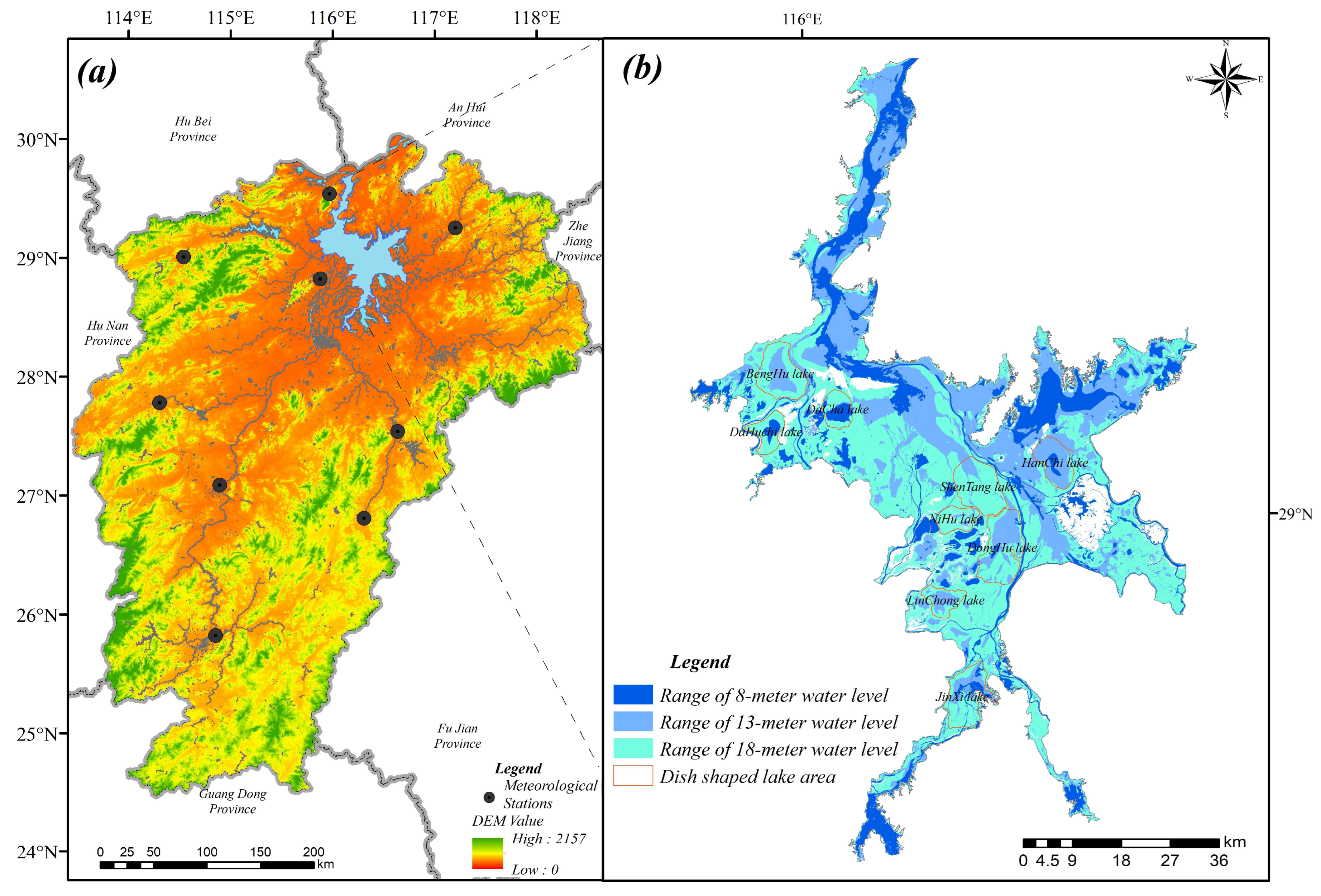
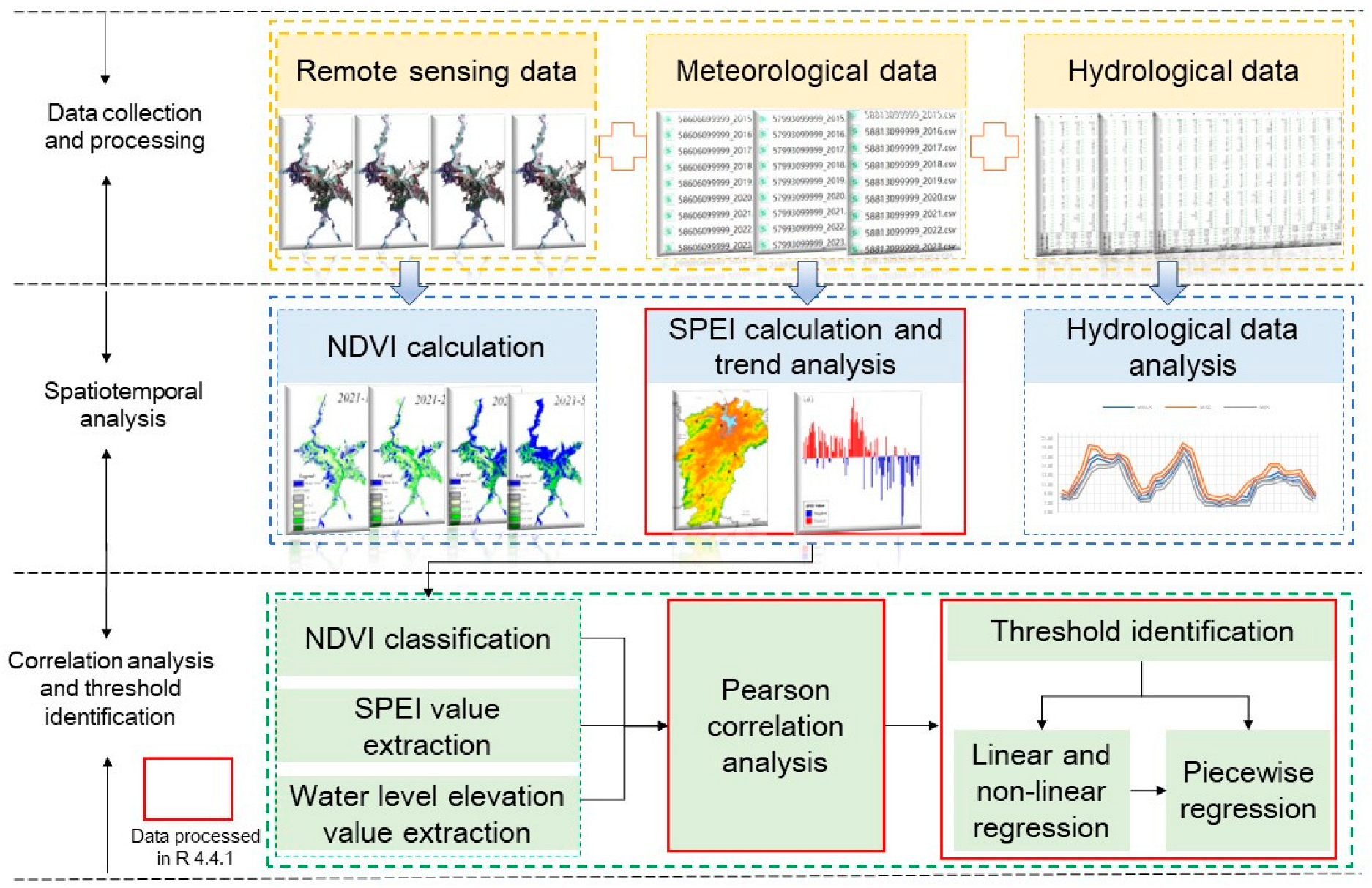
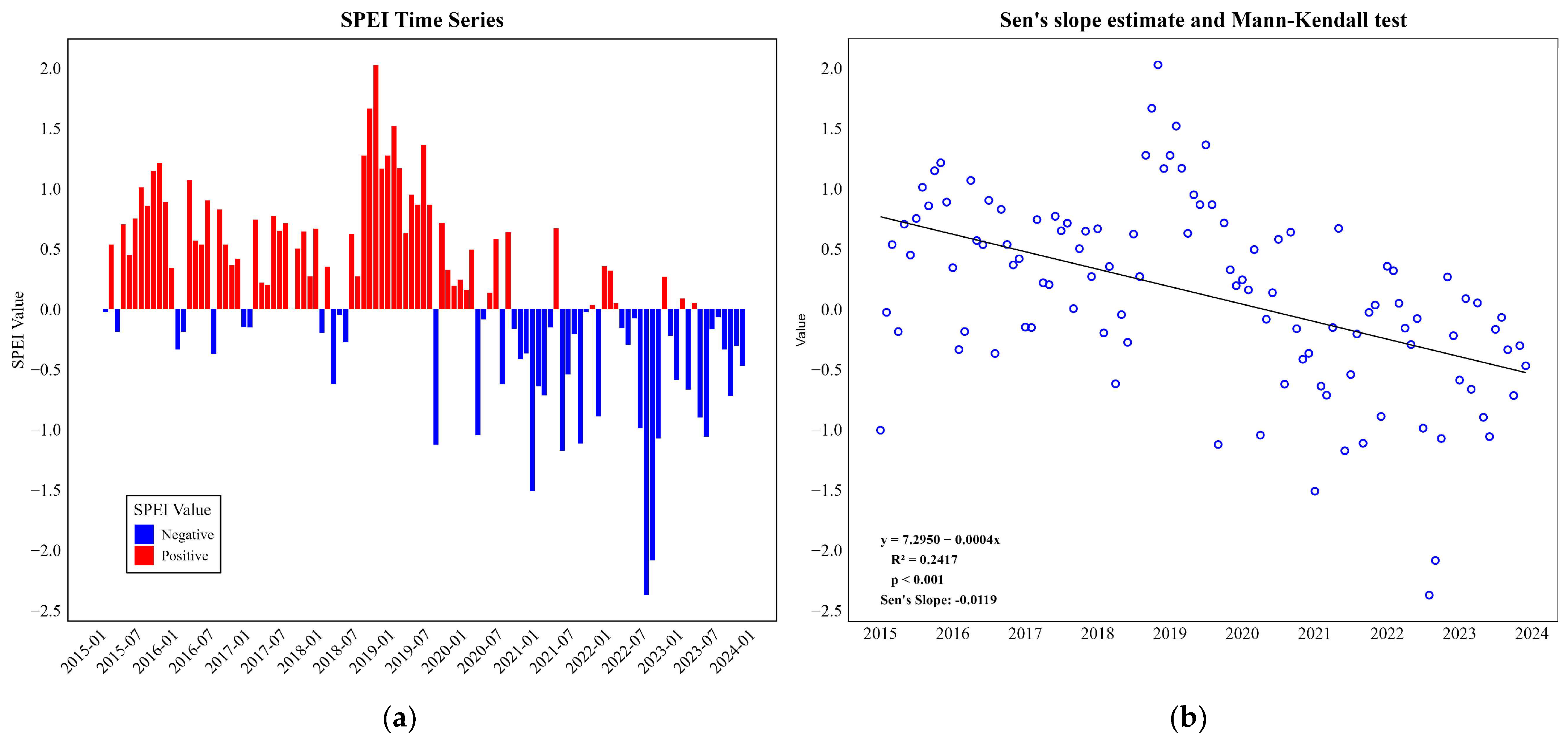
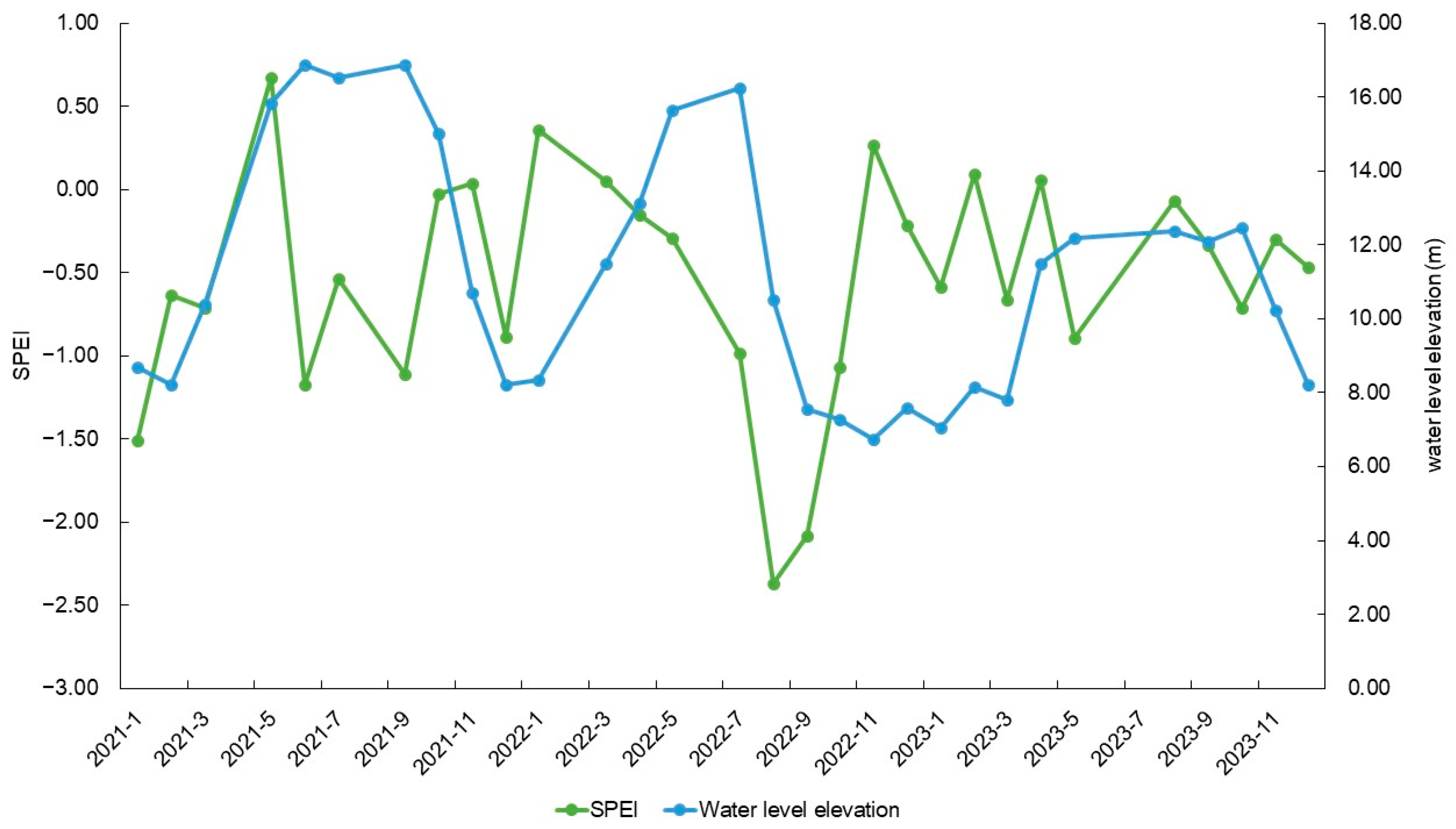

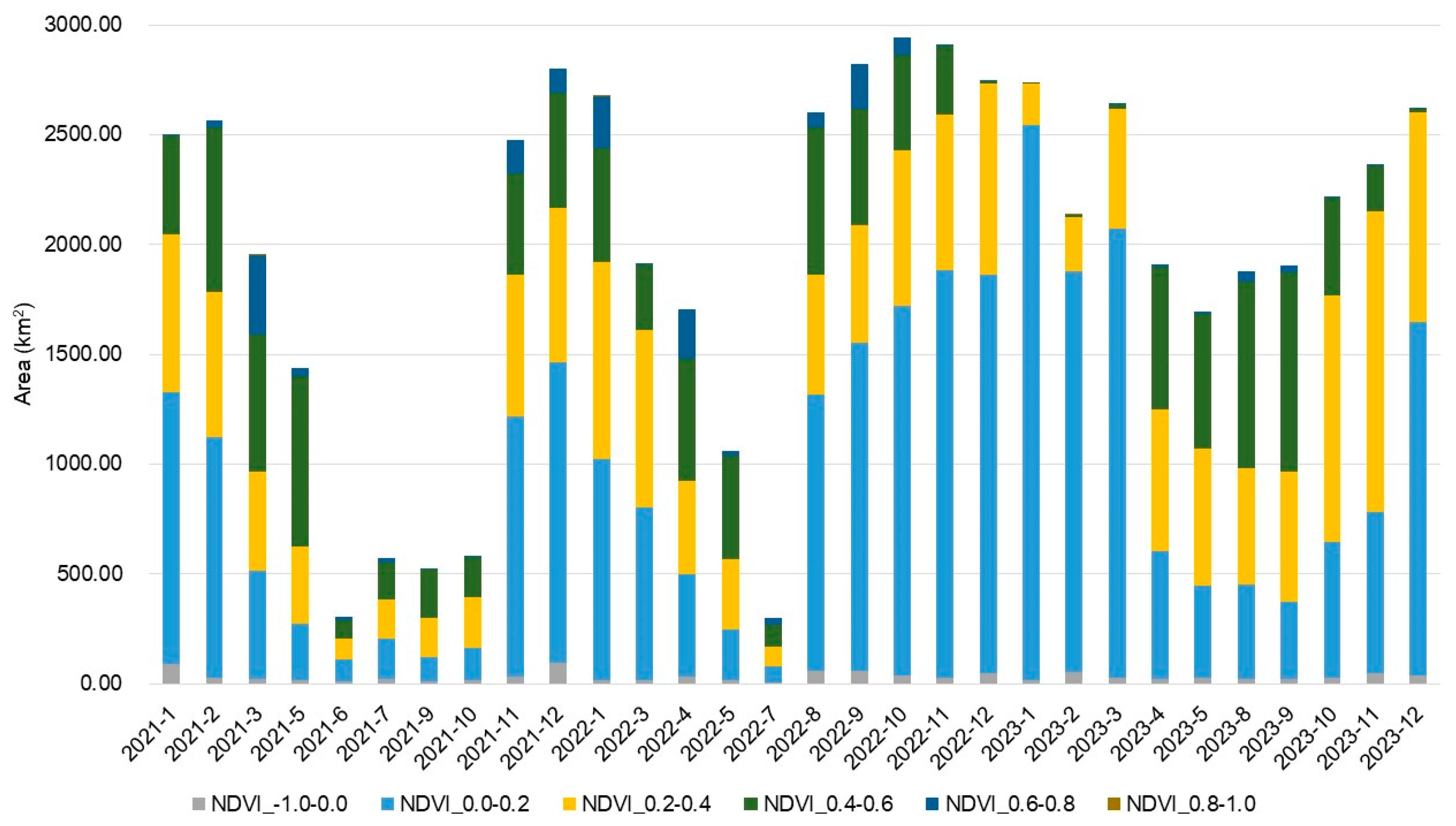

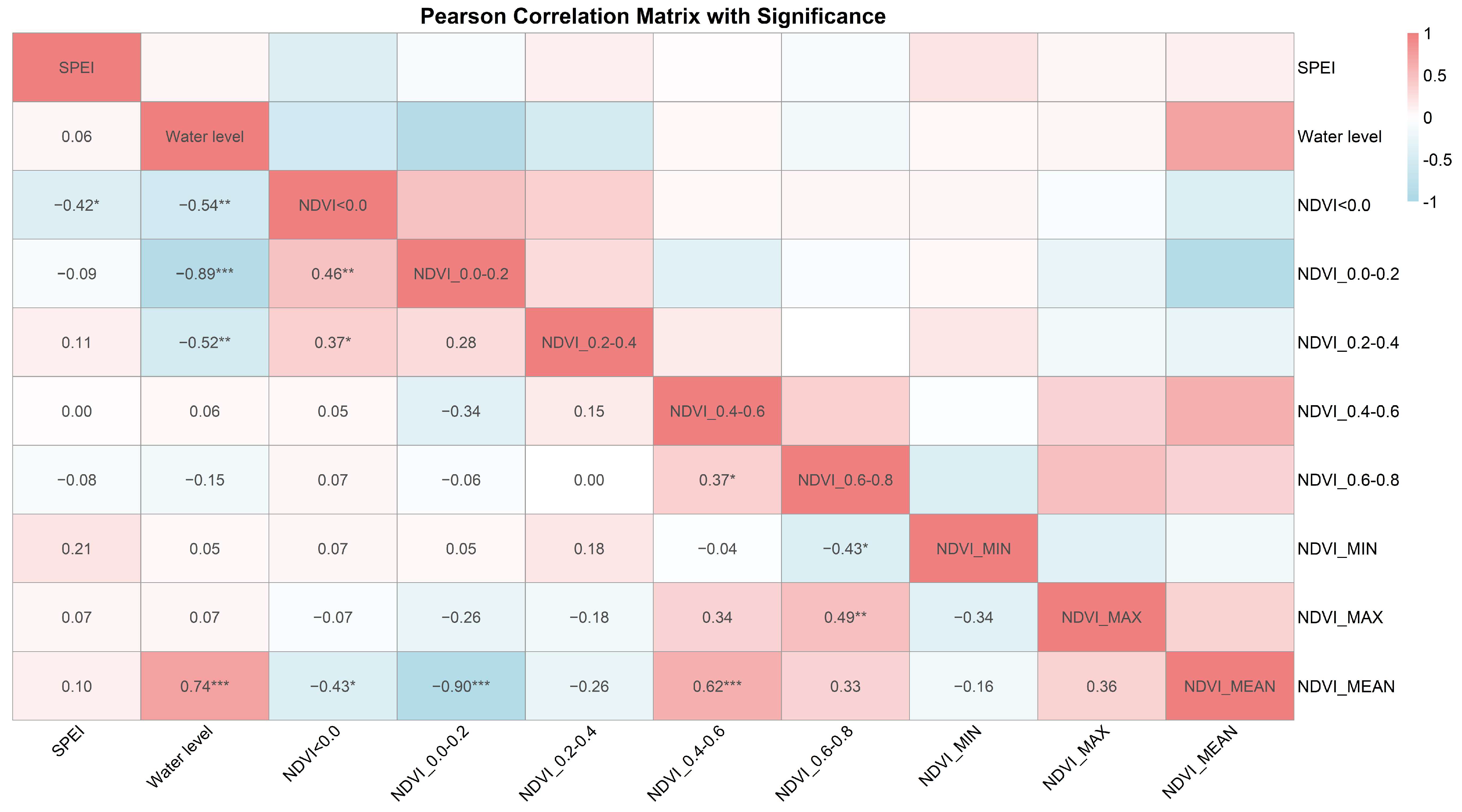
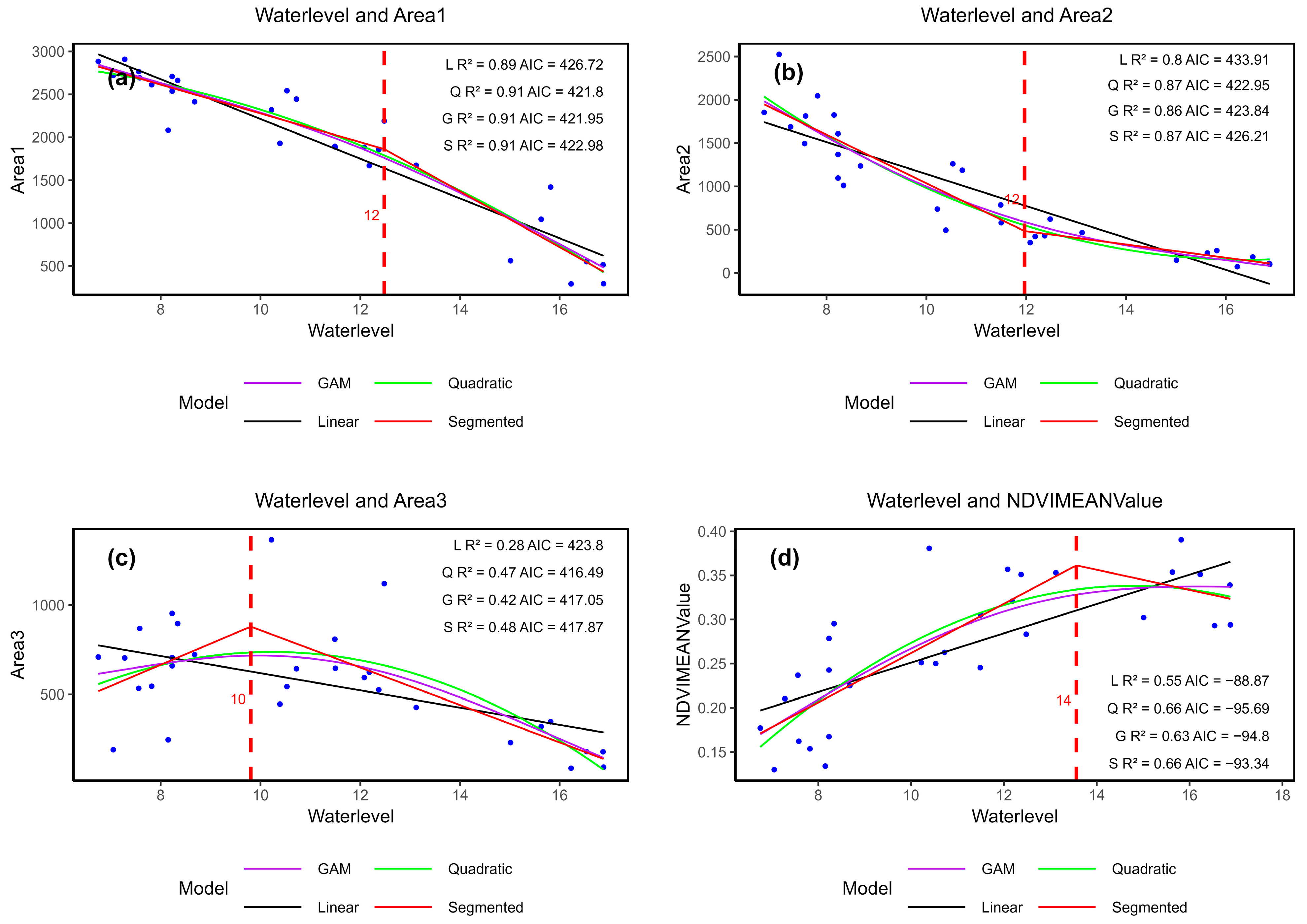
| Water Level Line (m) | Actual Water Level at Xingzi Station (m) | Date |
|---|---|---|
| 8 (Extremely low water period) | 8.05 | 11 January 2022 |
| 13 (Normal water period) | 12.51 | 11 April 2022 |
| 18 (High water period) | 17.48 | 10 July 2022 |
Disclaimer/Publisher’s Note: The statements, opinions and data contained in all publications are solely those of the individual author(s) and contributor(s) and not of MDPI and/or the editor(s). MDPI and/or the editor(s) disclaim responsibility for any injury to people or property resulting from any ideas, methods, instructions or products referred to in the content. |
© 2024 by the authors. Licensee MDPI, Basel, Switzerland. This article is an open access article distributed under the terms and conditions of the Creative Commons Attribution (CC BY) license (https://creativecommons.org/licenses/by/4.0/).
Share and Cite
Lai, X.; Zeng, H.; Zhao, X.; Shao, Y.; Guo, X. Impact of Extreme Drought on Vegetation Greenness in Poyang Lake Wetland. Forests 2024, 15, 1756. https://doi.org/10.3390/f15101756
Lai X, Zeng H, Zhao X, Shao Y, Guo X. Impact of Extreme Drought on Vegetation Greenness in Poyang Lake Wetland. Forests. 2024; 15(10):1756. https://doi.org/10.3390/f15101756
Chicago/Turabian StyleLai, Xiahua, Han Zeng, Xiaomin Zhao, Yiwen Shao, and Xi Guo. 2024. "Impact of Extreme Drought on Vegetation Greenness in Poyang Lake Wetland" Forests 15, no. 10: 1756. https://doi.org/10.3390/f15101756






